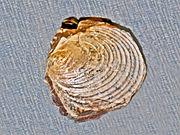| Inoceramus | |
|---|---|
 | |
| Scientific classification | |
| Domain: | Eukaryota |
| Kingdom: | Animalia |
| Phylum: | Mollusca |
| Class: | Bivalvia |
| Order: | Pteriida |
| Family: | † Inoceramidae |
| Genus: | † Inoceramus Sowerby, 1814 |
| Species | |
See text | |
Inoceramus (Greek: translation "fibrous shell" for the fibrous structure of the mineral crystals in the shell) is an extinct genus of fossil marine pteriomorphian bivalves that superficially resembled the related winged pearly oysters of the extant genus Pteria . They lived from the Early Jurassic to latest Cretaceous. [1] [2]
Contents
- Taxonomy
- Description
- Selected species
- Distribution
- Gallery
- References
- Bibliography
- Further reading
- External links
The English naturalist James Sowerby proposed the name Inoceramus at a meeting of the Linnean Society in London in 1814 but a text version was not published until 1822. He gave the etymology from Greek with Latin translation as: ἴς fibra [fiber] et κέραμος testa [shell]. The fibrous-appearing mineral structure of the shell inspired the name choice: "[I]t consists entirely of a substance composed of parallel perpendicular fibres, and much more conspicuously so than Pinna or any other genus". [3] [4]








